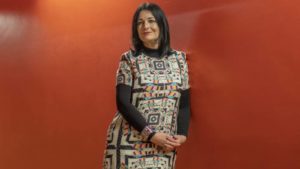
 As co-founder and creative director of East London design collective called body>data>space, 56-year-old Ms Boddington focuses on blending the virtual and physical by combining telepresence — using tech to participate in distant events — virtual worlds and experimental environments that can be controlled using physical gestures. These include 210-degree domes or “spheres” — entertainment venues in which a VR immersive experience can become a shared social activity rather than a singular one experienced via a headset.
As co-founder and creative director of East London design collective called body>data>space, 56-year-old Ms Boddington focuses on blending the virtual and physical by combining telepresence — using tech to participate in distant events — virtual worlds and experimental environments that can be controlled using physical gestures. These include 210-degree domes or “spheres” — entertainment venues in which a VR immersive experience can become a shared social activity rather than a singular one experienced via a headset.
So far, the use of VR technology has gained limited traction among women. Two-thirds say they are unlikely to try either VR or AR, according to a 2017 report by the consultancy EY, compared with half of men. “Like so many technologies, adoption happens when consumers don’t think about the technology itself but what it allows them to do,” says Martyn Whistler, an analyst at EY. Developing real-use applications in areas such as retail, tourism and fitness will demonstrate their value to women, he adds. Ms Boddington agrees. “A high proportion of VR content is male heterosexual porn,” she explains. “Content creators need to think in a much more diverse way” to broaden the technology’s appeal, she adds. She prefers to focus on the body from a different perspective. She uses the phrase “internet of bodies” to encompass the idea that the body should be central to the digital experience.
See the full story here: https://www.ft.com/content/79066ba0-dd43-11e8-b173-ebef6ab1374a